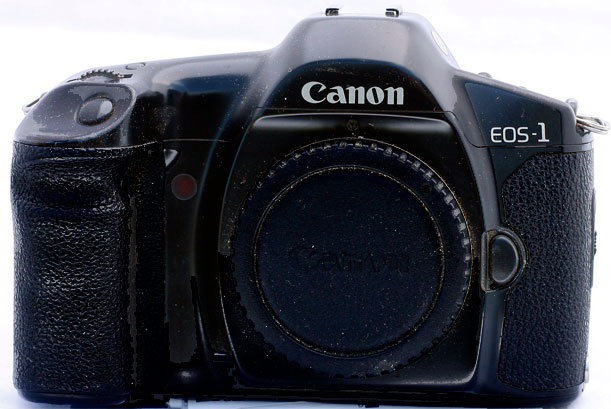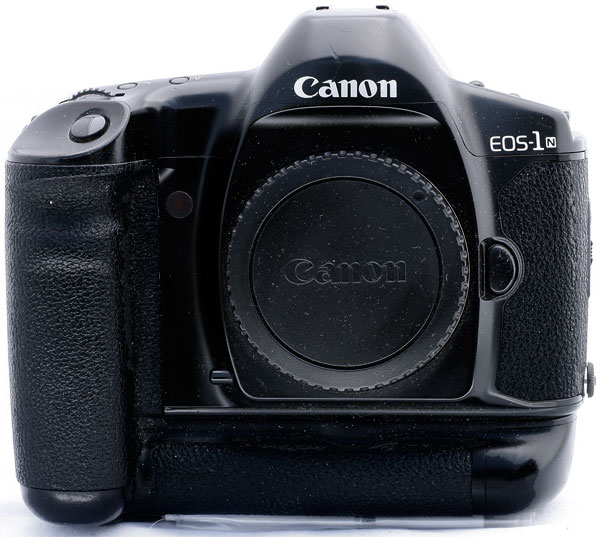

Lens Mount: EF bayonet
Approx. dates of manufacture: 1989-1994 (EOS-1); 1994-2001 (EOS-1n)
Battery: 2CR5 (or 4 AAs if using the optional battery pack shown on EOS-1n)
Approx. original price: $1,500 (EOS-1); $2,000 (EOS-1n)
Approx. street value: High moderate (EOS-1); High (EOS-1n)
In the relatively recent history of camera development, things tend to go in technological waves. There's a lot of overlap and this is very general, but in the 50s the big thing was flash synchronization. In the 60s it was integrating light meters directly into the camera. In the 70s it was exposure automation. In the 80s and 90s it was autofocus. Today (as I write this in 2007) it's digital and image stabilization.
In the 80s everyone was going to autofocus. Canon decided to ditch its long-established FD lens mount and went with the new EF mount, and a whole series of autofocus SLR cameras under the EOS line. As usual, Canon introduced its amateur-tier cameras first, then after some of the bugs were ironed out, they rolled out the top of the line professional camera, the EOS-1.
The EOS-1 ran for about five years, and then true to Canon marketing, they came out with a new version which they also named the EOS-1, but this time with a little n after. They're really different cameras (as were the original F-1 and the New F-1) but they look very similar. They also decided to add confusion by changing the designations based on accessories. So the EOS-1N is the base, but if you add the Battery Pack BP-E1, the camera becomes the EOS-1N DP. If you add the Power Drive Booster E-1, then the camera becomes a EOS-1N HS. However the EOS-1N RS is a different camera because it has a pellicle mirror (like my Canon Pellix).
The next (and last film version) of the camera was the EOS-1V. After that they went digital and that's a whole new thing entirely.
I have one of each as pictured. Bought them as a pair in the only condition I can afford these things—ailing. The eBay listing said that the original worked fine but wouldn't run in full-manual. I thought about it a lot and realized I very rarely shoot in full-manual, I typically run in one of the semi-automatic modes. The other camera was DOA and would have to go to the shop no matter what. I was surprised to find that together they cost less than I thought either would be alone (in working condition) so I bought them.
Cosmetically they look identical: other than the little N on the model designation, you really have to know what to look for to tell them apart. The 1N has five autofocus aiming points instead of one. It has a built-in viewfinder block (the 1 required you to use a plastic piece that was on the crappy neck strap. Yeah, right). Just about everything else is inside the camera and you can't see it: more custom functions, mirror lock up, better metering. The autofocus is a little faster. Smarter flash capability.
These are my first EOS series cameras. I was left behind in the auto-focus move in the 80s and 90s because, like a lot of people, I didn't want my FD lenses to suddenly become obsolete. It still bugs me that I have a nice range of focal lengths in FD and none of them can be used on these bodies. (Well, they can but I have to get a 3rd party adapter and I've heard it's of dubious quality. There's a Canon adapter but it's outrageously expensive). The cameras came with a short 35-70mm zoom so at least I have that, and I had a 35-80mm already. Neither are "good" but they were good enough to get me going.
I took the working one out and was surprised at how much fun it was. I spent my life manually focusing lenses and I figured I would hate the autofocus, but I was surprised to find how well it worked. I fought with it once and simply switched to manual, then quickly focused it myself. Switched it back to auto for the next shot and had no problems. Plus the camera is loaded with stuff that people take for granted now but are new and exciting for people like me: integrated power wind, exposure information inside the viewfinder, and of course the autofocus. Fun fun fun.
Later on, after I'd "fixed" my T90, I tried the same thing on the 1n and suddenly the camera came to life. Always check the battery contacts. Always.
For more information: Canon Camera Museum
Popular Photography magazine camera test for EOS-1: February 1991
Popular Photography magazine camera test for EOS-1n: June 1995
Modern Photography "SLR Notebook" column: September 1989
Camera manual: Orphan Cameras.com




.jpg)